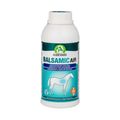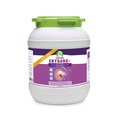The word laminitis is dreaded by riders around the world. It occurs much more frequently than you might think - about half of all cases are missed because the condition is not obvious to detect. However, it is a crippling condition for your horse and can eventually be fatal. It is estimated that laminitis occurs on average once every ten years of a horse's life. Knowing the risk factors and how to reduce the occurrence of laminitis is crucial, and to do this it is important to understand the disease.
What is laminitis? Why is it so painful?
The hoof for horses is similar to the nails for humans, except the horse uses them as feet. As in humans, the total weight of the horse is carried by the skeleton, which means that the bones bear a significant amount of weight, 30% of the horse's body weight in each forelimb, and 20% in each hind limb. The weight of the horse in the hoof does not rest directly on the hoof bone. Instead, the foot bone, called the 3rd phalanx, is suspended from the hoof wall, not by a ligament (because this would not allow the hoof to grow over the lifetime of a horse), but through a stratified system, the lamina. These are millions of tiny structures that intertwine to form a tissue that bridges the gap between the hoof horn and the bone.
So what is laminitis?
Laminitis is the inflammation of the laminae. As with any inflammation there is a swelling of the tissue, in this case in the laminae. This swelling has a negative effect on the way the laminae can interconnect between the 3rd phalanx bone and the hoof, and can therefore alter the distribution of the horse's weight on the 3rd phalanx bone and the hoof in contact with the ground.
How do I identify laminitis in my horse?
Your horse will lean back and may even lie down because of the pain. In a normal horse, most of the weight is carried by the front legs, during laminitis these are usually the most painful. Bending over backwards therefore allows your horse to relieve its front limbs by putting more weight on its hind limbs. Laminitis can also be expressed chronically by inconsistent hoof horn growth which is characterised by bumps on the hoof. The foot is said to be ringed.
How is laminitis treated?
Treatment includes pain relief and support of the foot with farriery. The use of anti-inflammatory drugs helps soothe the pain and prevent the horse from lying down without drinking or eating. Foot surgery can change the angle at which your horse puts its foot down, but also provide comfort when the horse puts its foot down and thus relieve the pain. There are also specific treatments depending on the cause of the laminitis: reducing the amount of food or modifying the diet, treating the disease at the origin...
How to prevent laminitis?
- Prevent overfeeding: Grain storage should be arranged so that it cannot be accessed by a horse escaping from its stall or paddock.
- Monitor the weight of the horses, obesity favours the development of laminitis.
- When putting the horse out to pasture, limit access to grass. This can be done by dividing up paddocks.
- Identify and manage horses at risk: Limit sugar-rich feed for overweight horses.
- Screening for Cushings disease and metabolic syndrome for horses at risk.
What causes laminitis?
There are many potential causes of laminitis:
Overloading: this is the case after an injury that results in the removal of support from one limb. The horse will overload the neighbouring limb and risk developing laminitis. Overloading can also occur in an overweight animal.
Endotoxemia: this complex word means a release of toxins into the body. This can occur as a result of an infection in the body such as pneumonia, severe colic or diarrhoea. But it can also happen as a result of eating sugar-rich foods such as young and/or rich grass in the pasture, or horses that escape from their stables and gorge themselves on grain.
Hormonal: there are two hormonal diseases that can lead to laminitis: Cushings syndrome and equine metabolic syndrome. Both diseases affect insulin.
The role of insulin in hormone-induced laminitis?
The first reason may seem obvious: the ingestion of sugar-rich feed. This can happen in different ways: young, rich grass in the pasture, or horses running away from their stable and eating grain. This will cause a rise in blood sugar levels, and in response the pancreas releases insulin into the bloodstream to control the sugar level.
Another reason may be insulin resistance. This is a condition similar to type II diabetes in humans, where the pancreas releases insulin but other tissues in the body do not respond to this insulin. For example: if horse A (no insulin resistance) and horse B (who has insulin resistance) are grazing side by side, then for both horses the blood sugar levels will rise due to the sugars in the grass. In both horses, the pancreas releases insulin. In Horse A, the other tissues respond to the insulin and remove the sugar/glucose from the bloodstream, thus lowering the blood sugar level. In horse B, however, the other tissues do not respond to insulin, the blood sugar level remains high, and the pancreas is continuously stimulated to release more and more insulin.
So whether it is the rich diet in a normal horse, or a 'normal' meal in a horse with insulin resistance, this results in higher insulin levels, which can lead to laminitis. An insulin resistant horse fed a diet high in sugars will almost certainly have acute and severe laminitis.
Which horses have insulin resistance? Some older horses may develop insulin resistance without other endocrine disorders. Apart from this, most insulin resistance is caused by Cushings syndrome and equine metabolic syndrome. Cushings syndrome is quite common in horses over 15 years of age. The symptoms described are specific but not all horses show these signs: muscle weakness in the back, hanging belly, difficulty shedding hair. So in any older horse with laminitis, it will be advisable to test for this disease, so that your horse can be medically treated, and to reduce the risk of laminitis in the future.
Metabolic syndrome affects horses of all ages. In this disease, the horse's fat contributes to insulin resistance and thus to laminitis. In most cases, especially in ponies, excessive fat can be seen with the naked eye as fat pads, especially on the shoulders, flanks and bun (under the mane). Note that a horse can suffer from both Cushings syndrome and metabolic syndrome.
Your vet can carry out tests to diagnose Cushings syndrome, metabolic syndrome and insulin resistance. There is medical treatment for horses with Cushings syndrome. For equine metabolic
syndrome there is no medication, the treatment involves regulating the horse's overall caloric intake to help it lose weight. If the horse is not overweight, exercise is recommended both for weight loss and to help the horse become insulin sensitive again.
An important part of treating a horse with laminitis is feeding. Access to pasture should generally be restricted, replacing it with soaked hay to lower the sugar content. Your vet can advise you on the best diet for your horse. Be careful not to create vitamin and mineral deficiencies. Supplementation with minerals and vitamins can prevent this without increasing the amount of sugar.
Finally, once the acute laminitis has been cured, attention should be paid to the new quality of the hoof horn as it grows back. Poor quality hooves can be painful for the horse and can worsen the symptoms of laminitis. The quality of hoof growth can be supported by supplementing with biotin, an important protein for hoof horn synthesis.
Written by: Audevard (Guest Author)






